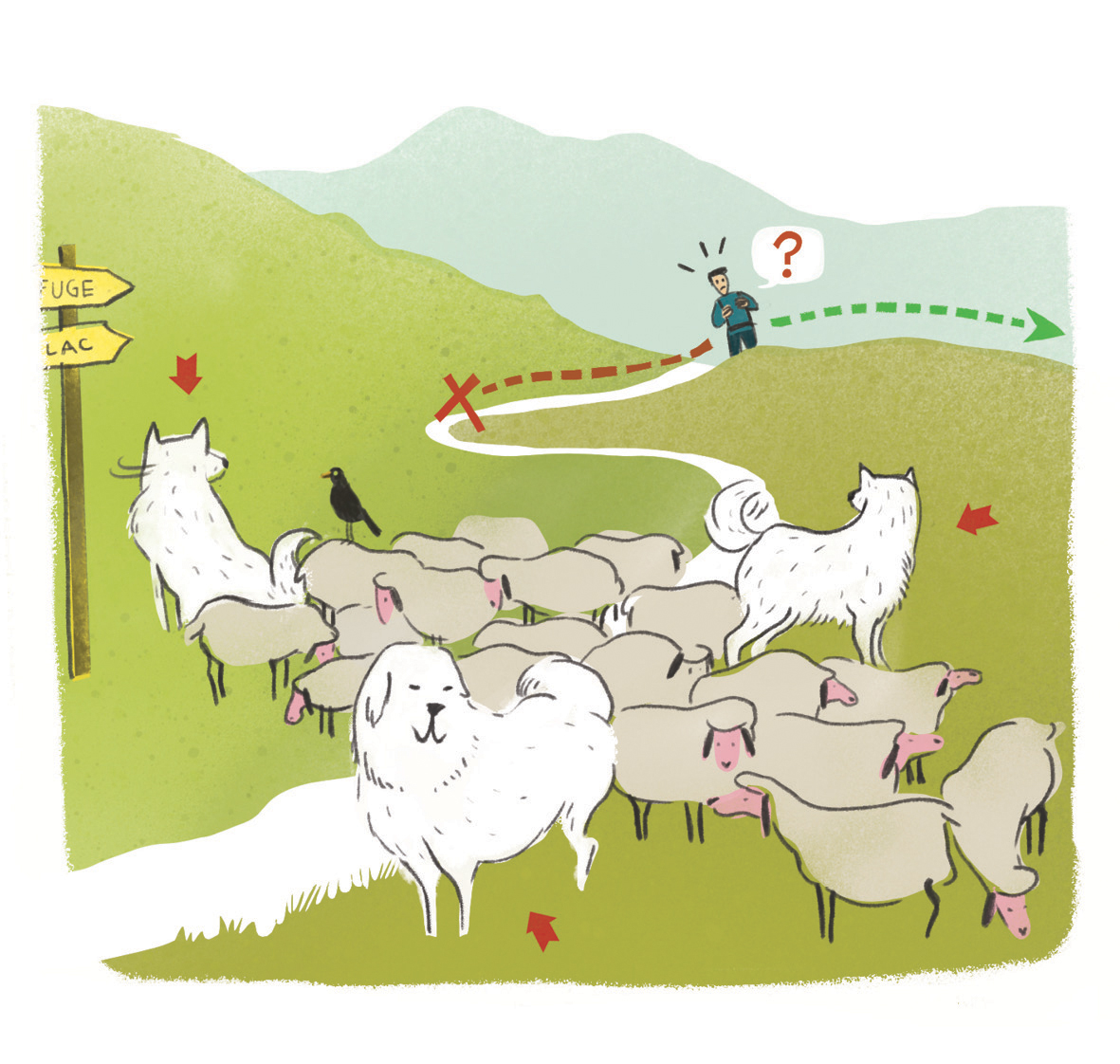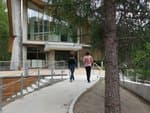The Dormillouse circuit
This circuit takes a closer look at the heights of Dormillouse via the meadowland. You can see how the village was adapted to the slope by the inhabitants. They knew they needed to build a narrow strip that was sheltered from avalanches. Over time, they developed architectural skills that have endured over time.
Description
Park at Les Cascades car park, at the end of the road and at the end of the Freissinières valley. Take the path on the left, where the entrance to the National Park is, and three information panels (you will pass a footbridge on the right that leads to the winter trail). Follow the "Dormillouse” route. Walk across the bridge over the Oules torrent and continue along the looping path alongside a large waterfall, then cross an area of scree.
- At the next crossroads, don’t take the path to the left (Lac du Fangeas, Col des Terres Blanches), but keep to the right, to the path leading to the meadow area, then turn left, following the signs to Lac Faravel, Lac Palluel and Col de Freissinières.
- At the next crossroads, turn right into the path towards an old stone bridge leading to the hamlet of Les Romans, above the village of Dormillouse.
- Go down into the village along the main path, past the school and the fountain, and you arrive at Les Enflous, then the windmill, before crossing the bridge and arriving at the path on the left that takes you back to the car park.
- Departure : Les Cascades, Dormillouse, Freissinières
- Towns crossed : Freissinières
Altimetric profile
Recommandations
The path leading to Dormillouse is only open in summer.
Please note: camping is forbidden, including near the car park.
 In mountain pastures, protection dogs are there to protect the herds from predators (wolves, etc.).
In mountain pastures, protection dogs are there to protect the herds from predators (wolves, etc.).
When I hike I adapt my behavior by going around the herd and pausing for the dog to identify me.
Find out more about the actions to adopt with the article "Protection dogs: a context and actions to adopt".
Tell us about your meeting by answering this survey.
Information desks
Vallouise Park house
, 05290 Vallouise
Information, documentation, models, exhibitions, screenings, product sales and works of the Park. Guided tours for school, reservation required. The new Park House opened in Vallouise since June 1, and offers visitors an interactive permanent exhibition inviting to explore the area and its heritage. A temporary exhibition space will allow a renewed offer. Finally, the device is completed by an audiovisual room to organize screenings and conferences Free admission. All animations of the Park are free unless otherwise stated.
Access and parking
From the RN 94, north of La Roche-de-Rame, head for Freissinières along the D38, then the D38B as far as Freissinières. Go through Freissinières, then turn right onto the D238 and go as far as the Cascades car park, at the end of the valley. This is the end of the road and the end of the Freissinières valley, except for periods of snow, when the road is closed.
Parking :
Sensitive areas
Golden eagle
- Impacted practices:
- Aerial, , Vertical
- Sensitivity periods:
- JanFebMarAprMayJunJulAug
- Contact:
- Parc National des Écrins
Julien Charron
julien.charron@ecrins-parcnational.fr
Black grouse - winter
- Impacted practices:
- , Land
- Sensitivity periods:
- JanFebMarAprDec
- Contact:
Black grouse - winter
- Impacted practices:
- , Land
- Sensitivity periods:
- JanFebMarAprDec
- Contact:
- Parc national des Ecrins - 0492402010
21 points of interest
 Archaeologie
ArchaeologieMines
A few remains of the exploitation of the ancient mine are disseminated around the sector of Fangeas. These mines go back to the Middle Ages, a period during which we exploited silver-lead and copper. It was a small exploitation, no doubt associated with the mines at Fournel. The metal mined was used to mint feudal currency. The mine works are now filled in and flooded, which has enabled us to find well preserved remains: scaffolding, turned wooden bowls, the sole of a shoe. Archeologists have been excavating the mine for the last ten years they started by siphoning off the flood water from the tunnels. The mines are not accessible to the public and we have deliberately not communicated their exact location. For more information about this heritage, contact the mining museum at l'Argentière la Bessée.
 Fauna
FaunaMarsh tit
This discreet tit is often confused with the mountain wollow tit. Distinguishing them is not easy. The bib of the marsh tit is smaller than that of the wollow tit; its wings are solid brown whereas they are slightly lighter for the wollow tit. Its crown is shinier. It is sedentary and visits the cooler deciduous forests, groves and garden providing there are trees with holes for nesting. It rarely goes higher than the mountain stage except for the most exposed sectors. With the arrival of spring, it does not come out of the old ash tree much. The best idea is to listen: the song and the call of the tit are very loud and tonic. Even then, it is not easy as it changes the song as if teasing the amateur ornithologist. Fauna
FaunaBlack Grouse
You will need to get up early if you want to see the Black Grouse in the summer. In France, the Black Grouse, or capercaillie as it is also known, can only be found in the Alps. The emblematic Black Grouse completes its biological cycle at the upper limit of the larch forest with springtime parades where the males coo and tackle each other, summer nesting supervised by the females and a winter lodging dug out of the snow. In winter, the Black Grouse is particularly sensitive to disturbance, such as an off-piste skier or snow-shoer passing by, as it cannot compensate for the energy lost should it need to flee its igloo in a hurry. Fauna
FaunaAlpine Accentor
An inveterate mountain-dweller, the alpine accentor is a sturdy passerine bird with a plump belly. A few black lines appear in its ashy feathers. It is characterised by the ginger flames on its sides. Found typically in the alpine prairies, it scampers across the short grass and crows on the bare stone. It comes to peck at the crumbs around the mountain refuge. When winter comes, it migrates towards the valleys. Its migration can even lead it as far as the rocks on the coast. When the snow melts, it is a formidable predator of small invertebrates numbed by the cold along the névé. It also gleans seeds, berries and small plants, explores the ledges, rummages in the cavities, and totters about, unsuspicious of its archenemy the hawk. Fauna
FaunaChamois
Emblematic animal of the Alps, the chamois, or "rock goat" have short black hooked horns. As with the ibex, they are easier to observe using binoculars. The females and the "éterlou" (young male under one year old) like to stay in a large herd whereas the males are more solitary and join the females for the mating season. In winter, the chamois hope for calm as they need to keep their reserves of fat to survive. Fauna
FaunaCommon kestrel
The common kestrel is a small diurnal bird of prey. The adult has a wingspan of approximately 70 cm and the female is generally bigger than the male. It can be distinguished from other birds of prey by its hovering flight, known as the "Flight of the Holy Spirit". It hovers immobile above its prey, waiting for the right moment to dive on it. It feed primarily on small rodents.
 Fauna
FaunaPontillat (bridge of stone)
The ancient charm of the bridge has led some to describe it as Roman, but it is of more recent construction. It spans the Chichin mountain stream above an impressive oule (or giant's cauldron) formed by the gradual erosion of the rock by stones tumbling over and over in the tumultuous waters. This is the starting point for a few very experienced thrill-seekers who canyon down it.
 Fauna
FaunaMountain hare
Lots of mountain hares, or blanchons, will have watched you as you pass by... the opposite is rarely true! Brown in the summer and white in winter, the blanchon is resident right across the Alps. It can be told apart from its cousin the brown hare by its smaller size, white tail and shorter ears, but they both leave distinctive Y shaped prints in the snow due to the way they bound along (the rear paws hit the ground ahead of the front paws). Their passage is often given away by their imprints and a few round, dry droppings. Their broad hair-covered paws act like snow shoes, helping to prevent them from sinking in even powdery snow.
 Fauna
FaunaRoe deer
There are roe deer in large numbers around the village of Dormillouse. Concealed in the bushes during the day and keeping to the meadow edges at dawn and dusk, they peacefully graze the tender grass. The white patch on its rump is called the «rump mirror». The rump mirror on the doe, the female, is heart-shaped and on the buck, the male, it is bean-shaped. Highly visible, when danger threatens the pale hairs stand up, enlarging it by way of warning to its companions.
 Fauna
FaunaThe Alpine marmot
According to one of numerous theories, the place name Dormillouse may have come from the word dormilhosa, which means marmot in the Provençal language. And marmots are indeed present in large number here, whistling and dashing around and above the village as soon as the snow has melted. The Alpine marmot is naturally present in the high-mountain grasslands. This large rodent is only active above ground from April to October, and in the cold season it retires to hibernate in its burrow. They live in family groups, respecting a strict hierarchy. Through playing, grooming, fighting and biting one dominant pair maintains its position, ensuring group cohesion. Each individual contributes to marking the boundaries of the group's territory, by rubbing its cheeks on rocks and leaving droppings and urine. When danger threatens, the marmot utters a loud, high-pitched whistle to warn its companions.
 Architecture
ArchitectureFélix Neff’s house
Félix Neff’s house dominates the village, up on the rock. Today it is in ruins. A project for its rehabilitation is waiting to be concretized lead by the Association of friends of Félix Neff. This house having been rehabilitated would be a place of memorial,reflexion and training within the continuity of the Neffien philosophy.
 History
HistoryFélix Neff, the apostle of the Hautes-Alpes
Protestant pastor from Geneva, Félix Neff (1797-1829) spent several years in the Hautes-Alpes where he worked as an evangelist, teacher, agronomist and engineer. He settled in Dormillouse in 1823, at the bottom of the Freissinières valley which was a refuge for the Vaudois. In this hamlet, he preached the Protestant word. As a good philanthropist, he contributed to the improvement of the life of the inhabitants by introducing the culture of the potato, by creating irrigation channels and improving the sanitation of the stables. In 1825 in Dormillouse, he founded the first « normal school » destined to train teachers for all the surrounding villages.
 Flora
FloraGiant Scabious
The presence of this Giant Scabious around Dormillouse village is linked to ancient agricultural practices..It can be recognized by its big size, its little yellow flower heads and its deeply divided leaves. The inflorescences (position of the flowers on the stalk) the Giant Scabious are all the same diameter, unlike other purple-violet scabious and field scabious.
 Flora
FloraGood King Henry
Also called Wild Spinach, Good King Henry is named after King Henri IV who advocated planting edible plants in order to overcome famine. It grows in tufts on ground that is rich in organic matter where sheep have been. A useful plant for mankind, its leaves can be used in all kinds of savory recipes.
 Pastoralism
PastoralismPastoralism
At the beginning of the summer, a flock of sheep graze around Dormillouse village. It sleeps in the heart of the village at night and during the siesta digestive at the hottest moment of the day. During the summer it moves to the sunny Jaline slope. Two other flocks are present in the valley during the summer : the first at Palluel and Chichin, the second at Faravel and in the Terres Blanches.
 Architecture
ArchitectureSchool Gîte
Set up in the ancient communal school where the parish priest once lived, the School Gîte at Dormillouse is open all year round for a relaxing pause, an alpine meal or a longer stay full or half-board.. There are 14 beds and hot showers.
 Architecture
ArchitectureProtestant Temple
The temple was built in 1758. It was originally destined for Catholic worship. However, all the inhabitants were Protestant, the building was always deserted. The priest stayed for 30 years before leaving. In this way the church was taken over by the Protestant faith.
 Flora
FloraStinking nightshade
Also called « Devil’s hand », this very poisonous plant grows in the rubble, on banks, at the edge of paths but also around cemeteries. An inhabitant of the Hautes-Alpes put forward the hypothesis that the seeds were placed in the coffins in order to preserve the clothes of the deceased. This strange flower with a black centre likes to move and rarely grows in the same place each year.
 History
HistoryInhabitants of Dormillouse
The inhabitants of Dormillouse are nicknamed the « Becarus ». This term signifies in Occitan « qui se rebèque », those who have an answer to everything, who have a sense of repartee. Originally, Beccaru was the nickname for Claude Baridon, who lived in Dormillouse. He became quite famous in 1660 when he opposed a local lord who wanted to take land away from the inhabitants.
 History
HistoryDormillouse and the Vaudois
In the 12th century, Pierre Valdo (or Valdès) founded the fraternity of the Poor of Lyons in reaction to the opulence of the Catholic church. Accompagnied by his disciples, he preached in the streets of Lyons. Chased from the city by the religious authorities, the Vaudois spread out in the Languedoc, in Provence and notably in the Freissinières valley. A few centuries later Dormillouse has been used as a place of shelter during times of intense persectution.
 History
HistoryPublic buildings at the heart of the hamlets
Uniquely, Dormillouse village consists of several quartiers or hamlets, each of these surrounds a public building: the mill at Enflous, at the bottom of the village the temple, the school and the Escleyers fountain ; the oven at Romans, at the top of the village. The stone and wooden dwellings are characteristic of alpine architecture in an isolated site.
Accessibility
More information
Source

Report a problem or an error
If you have found an error on this page or if you have noticed any problems during your hike, please report them to us here:


